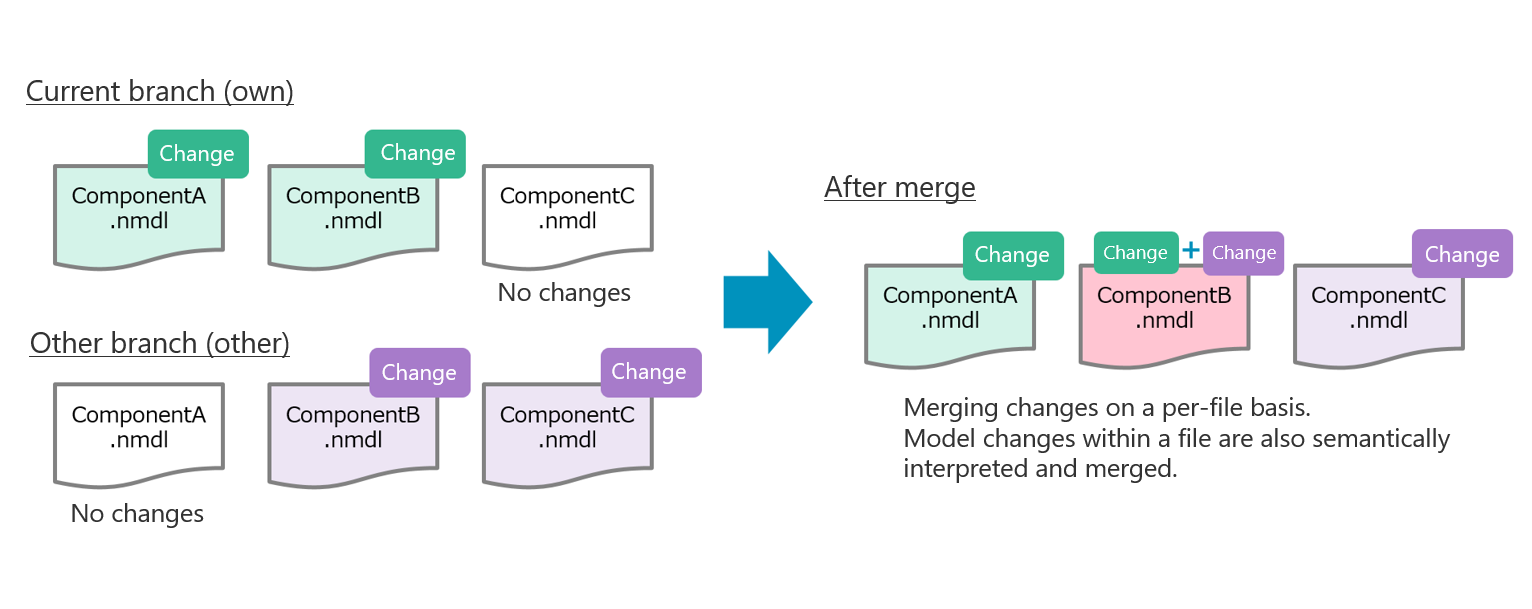Merging overview with NDMerge
Shows what NDMerge merges and what it does.
Merging branches

NDMergemerges Next Design data from the current branch (own) and the other branch (other) you specify.- Instead of merging text differences like the standard Git merge, it builds data for each Next Design file in memory and merges the differences for each model.
- It supports the following Next Design files, and builds data for each file.
- JSON format files
nprojnprofnmdl- DB format files
iprojiprofimdl- For example, build and merge the data of
ModelA.nmdlin the current branch (own) andModelA.nmdlin the specified other branch (other). Data in other model files has no effect on the merge ofModelA.nmdl.
Overview of merging by element
NDMerge does not handle the usual difference in changes made on a line-by-line basis, but handles changes made on a model-by-model basis as differences. The merged results are reflected in the Next Design file. If there are conflicts, an error occurs and the merge cannot be performed.
Merging models
- If there are no model conflicts between the current branch (own) and the specified other branch (other), you can merge field values, add or delete models, etc.
Merge example
- The model data for each branch is shown below.
//Example of base model
{
"Metamodel": "Use case",
"Fields": {
"Name": "Adaptive driving",
"Description": "Driving while maintaining distance from the vehicle ahead.",
"Scenarios$Embed": []
}
}
//Example of model of current branch (own)
{
"Metamodel": "Use case",
"Fields": {
"Name": "Adaptive driving", //Change the value of Name
"Description": "Driving while maintaining distance from the vehicle ahead.",
"Scenarios$Embed": [
//Add one scenario
{
"Metamodel": "Scenario",
"Fields": {
"Name": "Basic flow"
}
}
]
}
}
//Example of model for specified other branch (other)
{
"Metamodel": "Use case",
"Fields": {
"Name": "Adaptive driving",
"Description": "Driving while maintaining distance from the vehicle ahead. If there is no vehicle ahead, driving at a constant speed.", //Change the value of Description
"Scenarios$Embed": [
//Add one scenario
{
"Metamodel": "Scenario",
"Fields": {
"Name": "Exception flow (E1)"
}
}
]
}
}
- The above changes to own and other do not conflict, so the merge result is as shown below. In particular, adding an element to the
Scenariosfield is treated logically, and both own and other changes are merged.
//Example of model after merging
{
"Metamodel": "Use case",
"Fields": {
"Name": "Adaptive-Drive", //Merge own values
"Description": "Maintains distance from the vehicle ahead. If there is no vehicle ahead, the vehicle will drive at a constant speed.", //Merge other values
"Scenarios$Embed": [
//Merge both own and other
{
"Metamodel": "Scenario",
"Fields": {
"Name": "Basic flow"
}
},
{
"Metamodel": "Scenario",
"Fields": {
"Name": "Exception flow (E1)"
}
}
]
}
}
Merge display information
- The position and size of the diagram shapes, as well as styles such as background color and font, are merged with priority given to the current branch (own).
- Even if there are changes to the display information in the current branch (own) and the specified other branch (other), this will not be displayed as a conflict and the changes in the current branch (own) will be adopted.
- If a branch that takes priority for merging is specified in the options, the value of that branch will be adopted.
Merging Profiles
- If there are no profile conflicts between the current branch (own) and the specified other branch (other), you can merge additions and deletions of class and view definitions.
- If there are conflicts, the entire contents of one branch will be adopted and committed.
Changes that can be merged in the other branch will also be committed with the contents of the branch that adopted them.
References
- For information on resolving profile conflicts, see Modeling > Team Development with Git > User's Guide > Resolving Conflicts > Profile Conflicts.
Merging projects
- If there are no conflicts in project information between the current branch (own) and the specified other branch (other), you can merge them.